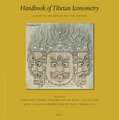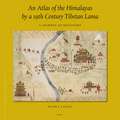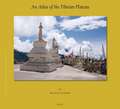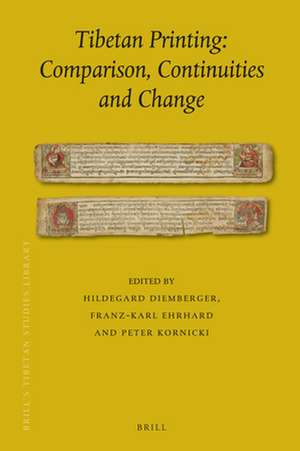Tibetan Printing: Comparison, Continuities, and Change: Brill's Tibetan Studies Library, cartea 39
Hildegard Diemberger, Karl Ehrhard, Peter F. Kornickien Limba Engleză Hardback – 8 iun 2016
Contributors are: Tim Barrett, Alessandro Boesi, Peter Burke, Michela Clemente, Hildegard Diemberger, Dorje Gyeltsen, Franz-Karl Ehrhard, Helmut Eimer, Johan Elverskog, Camillo Formigatti, Imre Galambos, Agnieszka Helman-Wazny, Tomasz Wazny, Sherab Sangpo Kawa, Peter Kornicki, Leonard van der Kuijp, Stefan Larsson, Ben Nourse, Anuradha Pallipurath, Porong Dawa, Paola Ricciardi, Tsering Dawa Sharshon, Sam van Schaik, Cristina Scherrer-Schaub, Marta Sernesi, Pasang Wangdu.
Din seria Brill's Tibetan Studies Library
- 18%
 Preț: 973.52 lei
Preț: 973.52 lei - 15%
 Preț: 499.08 lei
Preț: 499.08 lei - 18%
 Preț: 807.64 lei
Preț: 807.64 lei - 18%
 Preț: 905.94 lei
Preț: 905.94 lei - 18%
 Preț: 1003.21 lei
Preț: 1003.21 lei - 18%
 Preț: 739.91 lei
Preț: 739.91 lei - 18%
 Preț: 684.39 lei
Preț: 684.39 lei - 18%
 Preț: 533.44 lei
Preț: 533.44 lei - 18%
 Preț: 720.70 lei
Preț: 720.70 lei - 18%
 Preț: 929.05 lei
Preț: 929.05 lei - 18%
 Preț: 717.99 lei
Preț: 717.99 lei - 18%
 Preț: 716.81 lei
Preț: 716.81 lei - 18%
 Preț: 588.28 lei
Preț: 588.28 lei - 18%
 Preț: 905.08 lei
Preț: 905.08 lei - 18%
 Preț: 1848.85 lei
Preț: 1848.85 lei - 18%
 Preț: 705.39 lei
Preț: 705.39 lei - 18%
 Preț: 686.93 lei
Preț: 686.93 lei - 18%
 Preț: 689.48 lei
Preț: 689.48 lei - 18%
 Preț: 833.53 lei
Preț: 833.53 lei - 18%
 Preț: 721.38 lei
Preț: 721.38 lei - 18%
 Preț: 728.11 lei
Preț: 728.11 lei - 18%
 Preț: 853.30 lei
Preț: 853.30 lei - 18%
 Preț: 605.12 lei
Preț: 605.12 lei - 18%
 Preț: 606.44 lei
Preț: 606.44 lei - 18%
 Preț: 571.13 lei
Preț: 571.13 lei - 18%
 Preț: 918.07 lei
Preț: 918.07 lei - 18%
 Preț: 633.56 lei
Preț: 633.56 lei - 18%
 Preț: 959.89 lei
Preț: 959.89 lei - 18%
 Preț: 815.04 lei
Preț: 815.04 lei - 18%
 Preț: 606.12 lei
Preț: 606.12 lei - 5%
 Preț: 707.15 lei
Preț: 707.15 lei - 18%
 Preț: 549.53 lei
Preț: 549.53 lei - 18%
 Preț: 587.25 lei
Preț: 587.25 lei - 18%
 Preț: 594.02 lei
Preț: 594.02 lei - 18%
 Preț: 526.39 lei
Preț: 526.39 lei - 18%
 Preț: 626.07 lei
Preț: 626.07 lei - 15%
 Preț: 499.44 lei
Preț: 499.44 lei - 18%
 Preț: 753.80 lei
Preț: 753.80 lei - 18%
 Preț: 585.70 lei
Preț: 585.70 lei - 18%
 Preț: 660.73 lei
Preț: 660.73 lei - 18%
 Preț: 608.97 lei
Preț: 608.97 lei - 15%
 Preț: 479.01 lei
Preț: 479.01 lei - 18%
 Preț: 723.02 lei
Preț: 723.02 lei - 18%
 Preț: 1057.39 lei
Preț: 1057.39 lei - 18%
 Preț: 701.99 lei
Preț: 701.99 lei
Preț: 1117.78 lei
Preț vechi: 1363.14 lei
-18% Nou
Puncte Express: 1677
Preț estimativ în valută:
213.95€ • 232.48$ • 179.84£
213.95€ • 232.48$ • 179.84£
Carte indisponibilă temporar
Doresc să fiu notificat când acest titlu va fi disponibil:
Se trimite...
Preluare comenzi: 021 569.72.76
Specificații
ISBN-13: 9789004316065
ISBN-10: 900431606X
Dimensiuni: 155 x 235 mm
Greutate: 0.93 kg
Editura: Brill
Colecția Brill
Seria Brill's Tibetan Studies Library
ISBN-10: 900431606X
Dimensiuni: 155 x 235 mm
Greutate: 0.93 kg
Editura: Brill
Colecția Brill
Seria Brill's Tibetan Studies Library
Cuprins
Acknowledgements ix
List of Illustrations, Tables and Maps x
Introduction 1
PART ONE: The Introduction of Printing in the Asian Context: Wider Perspectives on Print and Manuscript Cultures
1 Three Print Revolutions 13 - Peter Burke
2 The Gutenberg Fallacy and the History of Printing among the Mongols 21 - Johan Elverskog
3 Mongolian Female Rulers as Patrons of Tibetan Printing at the Yuan Court: Some Preliminary Observations on Recently Discovered Materials 38 -
Kawa Sherab Sangpo
4 Empress Shōtoku as a Sponsor of Printing 45 - Peter Kornicki
5 From Chongzhen lishu 崇楨曆書 to Tengri-yin udq-a and Rgya rtsis chen mo 51 - Leonard W. J. van der Kuijp
6 A Forgotten Chapter in South Asian Book History? A Bird’s Eye View of Sanskrit Print Culture 72 - Camillo A. Formigatti
7 Manuscript and Print in the Tangut State: The Case of the Sunzi 135 - Imre Galambos
8 Printing versus Manuscript: History or Rhetoric? A Short Note Inspired by Pelliot DIC 153 - Cristina Scherrer-Schaub
9 The Uses of Early Tibetan Printing: Evidence from the Turfan Oasis 171 - Sam van Schaik
PART 2: The Introduction of Printing Into Tibet: Drivers, Impact and New Discoveries
10 New Discoveries in Early Tibetan Printing History 195 - Porong Dawa
11 Collected Writings as Xylographs: Two Sets from the Bo dong pa School 212 - Franz-Karl Ehrhard
12 Continuity and New Developments in 15th Century Tibetan Book Production: Bo dong Phyogs las rnam rgyal (1376–1451) and His Disciples as Producers of Manuscript and Print Editions 237 - Tsering Dawa Sharshon
13 Tibetan Women as Patrons of Printing and Innovation 267 - Hildegard Diemberger
14 Prints about the Printer: Four Early Prints in Honor of the Mad Yogin of gTsang 309 - Stefan Larsson
15 Works and Networks of mkhas pa Dri med. On the Illustrations of 16th Century Tibetan Printed Books 332 - Marta Sernesi
16 Early Book Production and Printing in Bhutan 369 - Dorji Gyaltsen
17 An Unacknowledged Revolution? A Reading of Tibetan Printing History on the Basis of Gung thang Colophons Studied in Two Dedicated Projects 394 - Michela Clemente
18 Revolutions of the Dharma Wheel: Uses of Tibetan Printing in the Eighteenth Century 424 - Benjamin J. Nourse
19 Observations Made in the Study of Tibetan Xylographs 451- Helmut Eimer
PART 3: Exploring the Materiality of Prints and Manuscripts
20 Wooden Book-covers, Printing Blocks, their Identification and Dating – How to Read the Wood 471 - Tomasz Ważny
21 The Five Colours of Art: Non-invasive Analysis of Pigments in Tibetan Prints and Manuscripts 485 -Paola Ricciardi and Anuradha Pallipurath
22 Paper Plants in the Tibetan World: A Preliminary Study 501 - Alessandro Boesi
23 The Choice of Materials in Early Tibetan Printed Books 532 - Agnieszka Helman-Ważny
24 Paper, Patronage and Production of Books: Remarks on an 11th Century Manuscript from Central Tibet 555 - Pasang Wangdu
25 Pattern Reproduction Possibilities and the Alpha and Omega of Tibetan Printing 560 - T. H. Barrett
Index 575
List of Illustrations, Tables and Maps x
Introduction 1
PART ONE: The Introduction of Printing in the Asian Context: Wider Perspectives on Print and Manuscript Cultures
1 Three Print Revolutions 13 - Peter Burke
2 The Gutenberg Fallacy and the History of Printing among the Mongols 21 - Johan Elverskog
3 Mongolian Female Rulers as Patrons of Tibetan Printing at the Yuan Court: Some Preliminary Observations on Recently Discovered Materials 38 -
Kawa Sherab Sangpo
4 Empress Shōtoku as a Sponsor of Printing 45 - Peter Kornicki
5 From Chongzhen lishu 崇楨曆書 to Tengri-yin udq-a and Rgya rtsis chen mo 51 - Leonard W. J. van der Kuijp
6 A Forgotten Chapter in South Asian Book History? A Bird’s Eye View of Sanskrit Print Culture 72 - Camillo A. Formigatti
7 Manuscript and Print in the Tangut State: The Case of the Sunzi 135 - Imre Galambos
8 Printing versus Manuscript: History or Rhetoric? A Short Note Inspired by Pelliot DIC 153 - Cristina Scherrer-Schaub
9 The Uses of Early Tibetan Printing: Evidence from the Turfan Oasis 171 - Sam van Schaik
PART 2: The Introduction of Printing Into Tibet: Drivers, Impact and New Discoveries
10 New Discoveries in Early Tibetan Printing History 195 - Porong Dawa
11 Collected Writings as Xylographs: Two Sets from the Bo dong pa School 212 - Franz-Karl Ehrhard
12 Continuity and New Developments in 15th Century Tibetan Book Production: Bo dong Phyogs las rnam rgyal (1376–1451) and His Disciples as Producers of Manuscript and Print Editions 237 - Tsering Dawa Sharshon
13 Tibetan Women as Patrons of Printing and Innovation 267 - Hildegard Diemberger
14 Prints about the Printer: Four Early Prints in Honor of the Mad Yogin of gTsang 309 - Stefan Larsson
15 Works and Networks of mkhas pa Dri med. On the Illustrations of 16th Century Tibetan Printed Books 332 - Marta Sernesi
16 Early Book Production and Printing in Bhutan 369 - Dorji Gyaltsen
17 An Unacknowledged Revolution? A Reading of Tibetan Printing History on the Basis of Gung thang Colophons Studied in Two Dedicated Projects 394 - Michela Clemente
18 Revolutions of the Dharma Wheel: Uses of Tibetan Printing in the Eighteenth Century 424 - Benjamin J. Nourse
19 Observations Made in the Study of Tibetan Xylographs 451- Helmut Eimer
PART 3: Exploring the Materiality of Prints and Manuscripts
20 Wooden Book-covers, Printing Blocks, their Identification and Dating – How to Read the Wood 471 - Tomasz Ważny
21 The Five Colours of Art: Non-invasive Analysis of Pigments in Tibetan Prints and Manuscripts 485 -Paola Ricciardi and Anuradha Pallipurath
22 Paper Plants in the Tibetan World: A Preliminary Study 501 - Alessandro Boesi
23 The Choice of Materials in Early Tibetan Printed Books 532 - Agnieszka Helman-Ważny
24 Paper, Patronage and Production of Books: Remarks on an 11th Century Manuscript from Central Tibet 555 - Pasang Wangdu
25 Pattern Reproduction Possibilities and the Alpha and Omega of Tibetan Printing 560 - T. H. Barrett
Index 575
Notă biografică
Hildegard Diemberger, D.Phil. (1992) University of Vienna, is Research Director at the Mongolia and Inner Asia Studies Unit, University of Cambridge, and Director of Studies in Human, Social and Political Sciences at Pembroke College, Cambridge. She has published monographs, translations and articles on the anthropology and history of Tibet and the Himalaya, including When a Woman becomes a Religious Dynasty : the Samding Dorje Phagmo of Tibet (Columbia University Press 2007).
Franz-Karl Ehrhard, D.Phil. (1987) Hamburg University, is Professor of Tibetan and Buddhist Studies at the University of Munich, Germany. His research work centres on religious and literary traditions in Tibet and the Himalayas. He has published extensively on the history of printing including the book Early Buddhist Block Prints from Mang-yul Gung-thang (Lumbini International Research Institute, 2000).
Peter Kornicki, D.Phil. (1979), University of Oxford, is Emeritus Professor of Japanese studies at the University of Cambridge and a Fellow of the British Academy. He has published numerous catalogues, monographs and articles.
Franz-Karl Ehrhard, D.Phil. (1987) Hamburg University, is Professor of Tibetan and Buddhist Studies at the University of Munich, Germany. His research work centres on religious and literary traditions in Tibet and the Himalayas. He has published extensively on the history of printing including the book Early Buddhist Block Prints from Mang-yul Gung-thang (Lumbini International Research Institute, 2000).
Peter Kornicki, D.Phil. (1979), University of Oxford, is Emeritus Professor of Japanese studies at the University of Cambridge and a Fellow of the British Academy. He has published numerous catalogues, monographs and articles.
Recenzii
"For me, the value of this book lies in the connections that it draws between the materiality of the book – its physical make-up and the labor of
production – and the sociopolitical and historical impact of the spread and dissemination of the knowledge contained within the books. To understand how this impact plays out in the telescoping contexts of Asia and then Tibet is key to a proper understanding of the region's intellectual and religious history, and the editors are to be congratulated on their innovative and vital contribution to this history."
Simon Wickhamsmith, Rutgers, The State University of New Jersey, Newbooks.Asia
production – and the sociopolitical and historical impact of the spread and dissemination of the knowledge contained within the books. To understand how this impact plays out in the telescoping contexts of Asia and then Tibet is key to a proper understanding of the region's intellectual and religious history, and the editors are to be congratulated on their innovative and vital contribution to this history."
Simon Wickhamsmith, Rutgers, The State University of New Jersey, Newbooks.Asia
